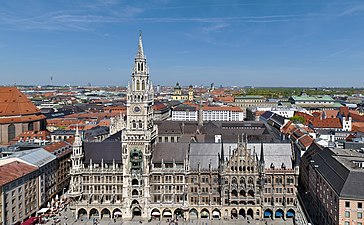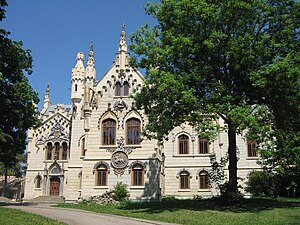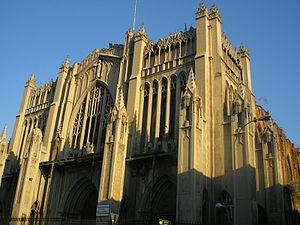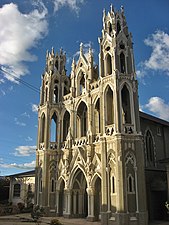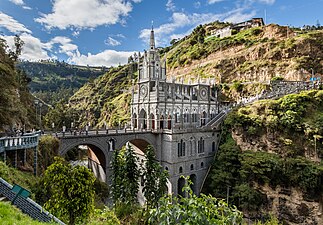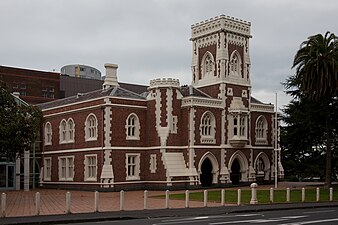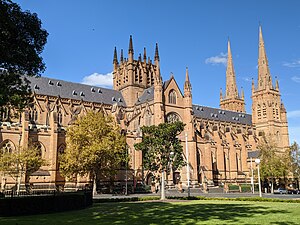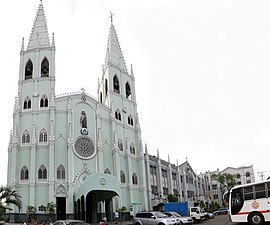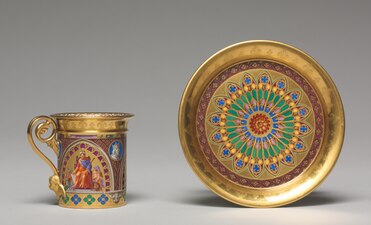Архитектура готического возрождения
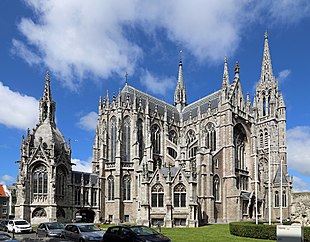
Готическое возрождение (также называемое викторианской готикой или неоготикой ) — архитектурное движение , которое после постепенного застройки, начавшегося во второй половине 17 века, стало широко распространенным движением в первой половине 19 века, в основном в Англии. . Все более серьезные и образованные поклонники стремились возродить средневековую готическую архитектуру , намереваясь дополнить или даже заменить неоклассические стили, преобладавшие в то время. Готическое возрождение опирается на особенности средневековых образцов, включая декоративные узоры, навершия , стрельчатые окна и формы капота . К середине 19-го века готическое возрождение стало выдающимся архитектурным стилем в западном мире , но начало выходить из моды в 1880-х и начале 1890-х годов.
Корни движения готического возрождения переплетаются с философскими движениями, связанными с католицизмом , и пробуждением высокой церкви или англо-католической веры, обеспокоенной ростом религиозного нонконформизма. «Англо-католическая» традиция религиозных верований и стилей стала известна своей внутренней привлекательностью в третьей четверти XIX века. Архитектура готического возрождения значительно различалась по своей верности как декоративным стилям, так и принципам строительства своего средневекового идеала, иногда сводясь к не более чем заостренным оконным рамам и штрихам неоготического декора на зданиях, которые в противном случае были созданы полностью по планам XIX века с использованием современных технологий. материалы и методы строительства; в первую очередь это включало использование железа, а после 1880-х годов и стали способами, никогда не встречавшимися в средневековых образцах.

In parallel with the ascendancy of neo-Gothic styles in 19th century England, interest spread to the rest of Europe, Australia, Africa and the Americas; the 19th and early 20th centuries saw the construction of very large numbers of Gothic Revival structures worldwide. The influence of Revivalism had nevertheless peaked by the 1870s. New architectural movements, sometimes related, as in the Arts and Crafts movement, and sometimes in outright opposition, such as Modernism, gained ground, and by the 1930s the architecture of the Victorian era was generally condemned or ignored.[by whom?] The later 20th century saw a revival of interest, manifested in the United Kingdom by the establishment of the Victorian Society in 1958.
Roots
[edit]The rise of evangelicalism in the eighteenth and early nineteenth centuries saw in England a reaction in the high church movement which sought to emphasise the continuity between the established church and the pre-Reformation Catholic church.[1] Architecture, in the form of the Gothic Revival, became one of the main weapons in the high church's armoury. The Gothic Revival was also paralleled and supported by "medievalism", which had its roots in antiquarian concerns with survivals and curiosities. As "industrialisation" progressed, a reaction against machine production and the appearance of factories also grew. Proponents of the picturesque such as Thomas Carlyle and Augustus Pugin took a critical view of industrial society and portrayed pre-industrial medieval society as a golden age. To Pugin, Gothic architecture was infused with the Christian values that had been supplanted by classicism and were being destroyed by industrialisation.[2]
Gothic Revival also took on political connotations; with the "rational" and "radical" Neoclassical style being seen as associated with republicanism and liberalism (as evidenced by its use in the United States and to a lesser extent in Republican France), the more spiritual and traditional Gothic Revival became associated with monarchism and conservatism, which was reflected by the choice of styles for the rebuilt government centres of the British parliament's Palace of Westminster in London, the Canadian Parliament Buildings in Ottawa and the Hungarian Parliament Building in Budapest.[3]
In English literature, the architectural Gothic Revival and classical Romanticism gave rise to the Gothic novel genre, beginning with The Castle of Otranto (1764) by Horace Walpole,[4] and inspired a 19th-century genre of medieval poetry that stems from the pseudo-bardic poetry of "Ossian". Poems such as "Idylls of the King" by Alfred, Lord Tennyson recast specifically modern themes in medieval settings of Arthurian romance. In German literature, the Gothic Revival also had a grounding in literary fashions.[5]
Survival and revival
[edit]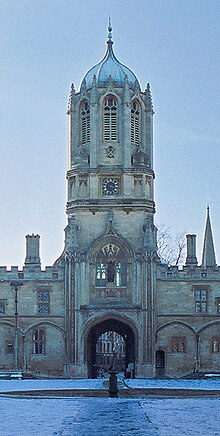
Gothic architecture began at the Basilica of Saint Denis near Paris, and the Cathedral of Sens in 1140[6] and ended with a last flourish in the early 16th century with buildings like Henry VII's Chapel at Westminster.[7] However, Gothic architecture did not die out completely in the 16th century but instead lingered in on-going cathedral-building projects; at Oxford and Cambridge Universities, and in the construction of churches in increasingly isolated rural districts of England, France, Germany, the Polish–Lithuanian Commonwealth and in Spain.[8]
Britain and Ireland
[edit]St Columb's Cathedral, in Derry, may be considered 'Gothic Survival', as it was completed in 1633 in a Perpendicular Gothic style.[9] Similarly, Gothic architecture survived in some urban settings during the later 17th century, as shown in Oxford and Cambridge, where some additions and repairs to Gothic buildings were considered to be more in keeping with the style of the original structures than contemporary Baroque.[10]
In contrast, Dromore Cathedral, built in 1660/1661, immediately after the end of the Protectorate, revived Early English forms, demonstrating the restitution of the monarchy and claiming Ireland for the English crown.[11] At the same time, the Great Hall of Lambeth Palace, that had been despoiled by the Puritans, was rebuilt in a mixture of Baroque and older Gothic forms, demonstrating the restitution of the Anglican Church.[12] These two buildings can be said to herald the onset of Gothic Revival architecture, several decades before it became mainstream. Sir Christopher Wren's Tom Tower for Christ Church, University of Oxford, consciously set out to imitate Cardinal Wolsey's architectural style. Writing to Dean Fell in 1681, he noted; "I resolved it ought to be Gothic to agree with the Founder's work", adding that to do otherwise would lead to "an unhandsome medley". Pevsner suggests that he succeeded "to the extent that innocent visitors never notice the difference". It was followed in 1697–1704 by the rebuilding of Collegiate Church of St Mary in Warwick as a stone-vaulted hall church, whereas the burnt church had been a basilica with timbered roofs. Also in Warwickshire, in 1729/30, the nave and aisles of the church of St Nicholas at Alcester were rebuilt by Edward and Thomas Woodward, the exterior in Gothic forms but with a Neoclassical interior.[13] At the same time, 1722–1746, Nicholas Hawksmoor added the west towers to Westminster Abbey, which made him a pioneer of Gothic Revival completions of medieval buildings,[14] which from the late 19th century were increasingly disapproved of, although work in this style continued into the 20th century.[15] Back in Oxford, the redecoration of the dining hall at University College between 1766 and 1768 has been described as "the first major example of the Gothic Revival style in Oxford".[a][17]
Continental Europe
[edit]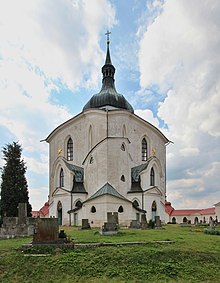
Throughout France in the 16th and 17th centuries, churches such as St-Eustache (1532–1640, façade 1754) in Paris and Orléans Cathedral (1601–1829) continued to be built following Gothic principles (structure of the buildings, application of tracery) with some little changes like the use of round arches instead of pointed arches and the application of some Classical details, until the arrival of Baroque architecture.[18]
In Bologna, in 1646, the Baroque architect Carlo Rainaldi constructed Gothic vaults (completed 1658) for the Basilica of San Petronio in Bologna, which had been under construction since 1390; there, the Gothic context of the structure overrode considerations of the current architectural mode. Similarly, in St. Salvator's Cathedral of Bruges, the timbered medieval vaults of nave and choir were replaced by "Gothic" stone vaults in 1635 resp. 1738/39. Guarino Guarini, a 17th-century Theatine monk active primarily in Turin, recognized the "Gothic order" as one of the primary systems of architecture and made use of it in his practice.[19]
Even in Central Europe of the late 17th and 18th centuries, where Baroque dominated, some architects used elements of the Gothic style. The most important example is Jan Santini Aichel, whose Pilgrimage Church of Saint John of Nepomuk in Žďár nad Sázavou, Czech Republic, represents a peculiar and creative synthesis of Baroque and Gothic.[20] An example of another and less striking use of the Gothic style in the time is the Basilica of Our Lady of Hungary in Márianosztra, Hungary, whose choir (adjacent to a Baroque nave) was long considered authentically Gothic, because the 18th-century architect used medieval shapes to emphasize the continuity of the monastic community with its 14th-century founders.[21]
Romantic challenges
[edit]During the mid-18th century rise of Romanticism, an increased interest and awareness of the Middle Ages among influential connoisseurs created a more appreciative approach to selected medieval arts, beginning with church architecture, the tomb monuments of royal and noble personages, stained glass, and late Gothic illuminated manuscripts. Other Gothic arts, such as tapestries and metalwork, continued to be disregarded as barbaric and crude, however sentimental and nationalist associations with historical figures were as strong in this early revival as purely aesthetic concerns.[22]
German Romanticists (including philosopher and writer Goethe and architect Karl Friedrich Schinkel), began to appreciate the picturesque character of ruins—"picturesque" becoming a new aesthetic quality—and those mellowing effects of time that the Japanese call wabi-sabi and that Horace Walpole independently admired, mildly tongue-in-cheek, as "the true rust of the Barons' wars".[b][24] The "Gothick" details of Walpole's Twickenham villa, Strawberry Hill House begun in 1749, appealed to the rococo tastes of the time,[c][26] and were fairly quickly followed by James Talbot at Lacock Abbey, Wiltshire.[27] By the 1770s, thoroughly neoclassical architects such as Robert Adam and James Wyatt were prepared to provide Gothic details in drawing-rooms, libraries and chapels and, for William Beckford at Fonthill in Wiltshire, a complete romantic vision of a Gothic abbey.[d][30]
Some of the earliest architectural examples of the revived are found in Scotland. Inveraray Castle, constructed from 1746 for the Duke of Argyll, with design input from William Adam, displays the incorporation of turrets.[e] The architectural historian John Gifford writes that the castellations were the "symbolic assertion of the still quasi-feudal power [the duke] exercised over the inhabitants within his heritable jurisdictions".[32] Most buildings were still largely in the established Palladian style, but some houses incorporated external features of the Scots baronial style. Robert Adam's houses in this style include Mellerstain[33] and Wedderburn[34] in Berwickshire and Seton Castle in East Lothian,[35] but it is most clearly seen at Culzean Castle, Ayrshire, remodelled by Adam from 1777.[36] The eccentric landscape designer Batty Langley even attempted to "improve" Gothic forms by giving them classical proportions.[37]

A younger generation, taking Gothic architecture more seriously, provided the readership for John Britton's series Architectural Antiquities of Great Britain, which began appearing in 1807.[38] In 1817, Thomas Rickman wrote an Attempt... to name and define the sequence of Gothic styles in English ecclesiastical architecture, "a text-book for the architectural student". Its long antique title is descriptive: Attempt to discriminate the styles of English architecture from the Conquest to the Reformation; preceded by a sketch of the Grecian and Roman orders, with notices of nearly five hundred English buildings. The categories he used were Norman, Early English, Decorated, and Perpendicular. It went through numerous editions, was still being republished by 1881, and has been reissued in the 21st century.[f][40]
The most common use for Gothic Revival architecture was in the building of churches. Major examples of Gothic cathedrals in the U.S. include the cathedrals of St. John the Divine and St. Patrick in New York City and the Washington National Cathedral on Mount St. Alban in northwest Washington, D.C. One of the biggest churches in Gothic Revival style in Canada is the Basilica of Our Lady Immaculate in Guelph, Ontario.[41]
Gothic Revival architecture remained one of the most popular and long-lived of the many revival styles of architecture. Although it began to lose force and popularity after the third quarter of the 19th century in commercial, residential and industrial fields, some buildings such as churches, schools, colleges and universities were still constructed in the Gothic style, often known as "Collegiate Gothic", which remained popular in England, Canada and in the United States until well into the early to mid-20th century. Only when new materials, like steel and glass along with concern for function in everyday working life and saving space in the cities, meaning the need to build up instead of out, began to take hold did the Gothic Revival start to disappear from popular building requests.[42]
Gothic Revival in the other decorative arts
[edit]
The revived Gothic style was not limited to architecture. Classical Gothic buildings of the 12th to 16th Centuries were a source of inspiration to 19th-century designers in numerous fields of work. Architectural elements such as pointed arches, steep-sloping roofs and fancy carvings like lace and lattice work were applied to a wide range of Gothic Revival objects. Some examples of Gothic Revival influence can be found in heraldic motifs in coats of arms, furniture with elaborate painted scenes like the whimsical Gothic detailing in English furniture is traceable as far back as Lady Pomfret's house in Arlington Street, London (1740s),[43] and Gothic fretwork in chairbacks and glazing patterns of bookcases is a familiar feature of Chippendale's Director (1754, 1762), where, for example, the three-part bookcase employs Gothic details with Rococo profusion, on a symmetrical form.[44][45] Abbotsford in the Scottish Borders, rebuilt from 1816 by Sir Walter Scott and paid for by the profits from his hugely successful, historical novels, exemplifies the "Regency Gothic" style.[g][47] Gothic Revival also includes the reintroduction of medieval clothes and dances in historical re-enactments staged especially in the second part of the 19th century, although one of the first, the Eglinton Tournament of 1839, remains the most famous.[48]
During the Bourbon Restoration in France (1814–1830) and the Louis-Philippe period (1830–1848), Gothic Revival motifs start to appear, together with revivals of the Renaissance and of Rococo. During these two periods, the vogue for medieval things led craftsmen to adopt Gothic decorative motifs in their work, such as bell turrets, lancet arches, trefoils, Gothic tracery and rose windows. This style was also known as "Cathedral style" ("À la catédrale").[49][50]
By the mid-19th century, Gothic traceries and niches could be inexpensively re-created in wallpaper, and Gothic blind arcading could decorate a ceramic pitcher. Writing in 1857, J. G. Crace, an influential decorator from a family of influential interior designers, expressed his preference for the Gothic style: "In my opinion there is no quality of lightness, elegance, richness or beauty possessed by any other style... [or] in which the principles of sound construction can be so well carried out".[51] The illustrated catalogue for the Great Exhibition of 1851 is replete with Gothic detail, from lacemaking and carpet designs to heavy machinery. Nikolaus Pevsner's volume on the exhibits at the Great Exhibition, High Victorian Design published in 1951, was an important contribution to the academic study of Victorian taste and an early indicator of the later 20th century rehabilitation of Victorian architecture and the objects with which they decorated their buildings.[52]
In 1847, eight thousand British crown coins were minted in proof condition with the design using an ornate reverse in keeping with the revived style. Considered by collectors to be particularly beautiful, they are known as 'Gothic crowns'. The design was repeated in 1853, again in proof. A similar two shilling coin, the 'Gothic florin' was minted for circulation from 1851 to 1887.[53][54]
Romanticism and nationalism
[edit]
French neo-Gothic had its roots in the French medieval Gothic architecture, where it was created in the 12th century. Gothic architecture was sometimes known during the medieval period as the "Opus Francigenum", (the "French Art"). French scholar Alexandre de Laborde wrote in 1816 that "Gothic architecture has beauties of its own",[55] which marked the beginning of the Gothic Revival in France. Starting in 1828, Alexandre Brogniart, the director of the Sèvres porcelain manufactory, produced fired enamel paintings on large panes of plate glass, for King Louis-Philippe's Chapelle royale de Dreux, an important early French commission in Gothic taste,[56] preceded mainly by some Gothic features in a few jardins paysagers.[57]
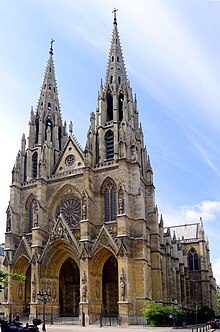
The French Gothic Revival was set on more sound intellectual footings by a pioneer, Arcisse de Caumont, who founded the Societé des Antiquaires de Normandie at a time when antiquaire still meant a connoisseur of antiquities, and who published his great work on architecture in French Normandy in 1830.[58] The following year Victor Hugo's historical romance novel The Hunchback of Notre-Dame appeared, in which the great Gothic cathedral of Paris was at once a setting and a protagonist in a hugely popular work of fiction. Hugo intended his book to awaken a concern for the surviving Gothic architecture left in Europe, however, rather than to initiate a craze for neo-Gothic in contemporary life.[59] In the same year that Notre-Dame de Paris appeared, the new restored Bourbon monarchy established an office in the Royal French Government of Inspector-General of Ancient Monuments, a post which was filled in 1833 by Prosper Mérimée, who became the secretary of a new Commission des Monuments Historiques in 1837.[60] This was the Commission that instructed Eugène Viollet-le-Duc to report on the condition of the Abbey of Vézelay in 1840.[61] Following this, Viollet le Duc set out to restore most of the symbolic buildings in France including Notre Dame de Paris,[62] Vézelay,[63] Carcassonne,[64] Roquetaillade castle,[65] Mont-Saint-Michel Abbey on its peaked coastal island,[66] Pierrefonds,[67] and the Palais des Papes in Avignon.[64] When France's first prominent neo-Gothic church[h] was built, the Basilica of Saint-Clotilde,[i] Paris, begun in 1846 and consecrated in 1857, the architect chosen was of German extraction, Franz Christian Gau, (1790–1853); the design was significantly modified by Gau's assistant, Théodore Ballu, in the later stages, to produce the pair of flèches that crown the west end.[70]

In Germany, there was a renewal of interest in the completion of Cologne Cathedral. Begun in 1248, it was still unfinished at the time of the revival. The 1820s "Romantic" movement brought a new appreciation of the building, and construction work began once more in 1842, marking a German return for Gothic architecture. St. Vitus Cathedral in Prague, begun in 1344, was also completed in the mid-19th and early 20th centuries.[71] The importance of the Cologne completion project in German-speaking lands has been explored by Michael J. Lewis, "The Politics of the German Gothic Revival: August Reichensperger". Reichensperger was himself in no doubt as to the cathedral's central position in Germanic culture; "Cologne Cathedral is German to the core, it is a national monument in the fullest sense of the word, and probably the most splendid monument to be handed down to us from the past".[72]
Because of Romantic nationalism in the early 19th century, the Germans, French and English all claimed the original Gothic architecture of the 12th century era as originating in their own country. The English boldly coined the term "Early English" for "Gothic", a term that implied Gothic architecture was an English creation. In his 1832 edition of Notre Dame de Paris, author Victor Hugo said "Let us inspire in the nation, if it is possible, love for the national architecture", implying that "Gothic" is France's national heritage. In Germany, with the completion of Cologne Cathedral in the 1880s, at the time its summit was the world's tallest building, the cathedral was seen as the height of Gothic architecture.[73] Other major completions of Gothic cathedrals were of Regensburger Dom (with twin spires completed from 1869 to 1872),[74] Ulm Münster (with a 161-meter tower from 1890)[75] and St. Vitus Cathedral in Prague (1844–1929).[76]

In Belgium, a 15th-century church in Ostend burned down in 1896. King Leopold II funded its replacement, the Saint Peter's and Saint Paul's Church, a cathedral-scale design which drew inspiration from the neo-Gothic Votive Church in Vienna and Cologne Cathedral.[77] In Mechelen, the largely unfinished building drawn in 1526 as the seat of the Great Council of The Netherlands, was not actually built until the early 20th century, although it closely followed Rombout II Keldermans's Brabantine Gothic design, and became the 'new' north wing of the City Hall.[78][79] In Florence, the Duomo's temporary façade erected for the Medici-House of Lorraine nuptials in 1588–1589, was dismantled, and the west end of the cathedral stood bare again until 1864, when a competition was held to design a new façade suitable to Arnolfo di Cambio's original structure and the fine campanile next to it. This competition was won by Emilio De Fabris, and so work on his polychrome design and panels of mosaic was begun in 1876 and completed by 1887, creating the Neo-Gothic western façade.[80]
Eastern Europe also saw much Revival construction; in addition to the Hungarian Parliament Building in Budapest,[3] the Bulgarian National Revival saw the introduction of Gothic Revival elements into its vernacular ecclesiastical and residential architecture. The largest project of the Slavine School is the Lopushna Monastery cathedral (1850–1853), though later churches such as Saint George's Church, Gavril Genovo display more prominent vernacular Gothic Revival features.[81]
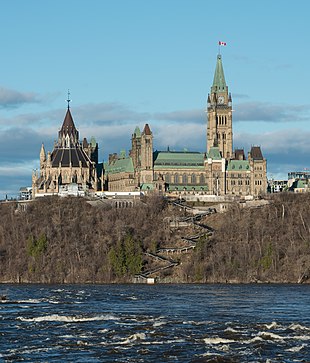
In Scotland, while a similar Gothic style to that used further south in England was adopted by figures including Frederick Thomas Pilkington (1832–1898)[82] in secular architecture it was marked by the re-adoption of the Scots baronial style.[83] Important for the adoption of the style in the early 19th century was Abbotsford, which became a model for the modern revival of the baronial style.[84] Common features borrowed from 16th- and 17th-century houses included battlemented gateways, crow-stepped gables, pointed turrets and machicolations. The style was popular across Scotland and was applied to many relatively modest dwellings by architects such as William Burn (1789–1870), David Bryce (1803–1876),[85] Edward Blore (1787–1879), Edward Calvert (c. 1847–1914) and Robert Stodart Lorimer (1864–1929) and in urban contexts, including the building of Cockburn Street in Edinburgh (from the 1850s) as well as the National Wallace Monument at Stirling (1859–1869).[86] The reconstruction of Balmoral Castle as a baronial palace and its adoption as a royal retreat from 1855 to 1858 confirmed the popularity of the style.[84]
In the United States, the first "Gothic stile"[87] church (as opposed to churches with Gothic elements) was Trinity Church on the Green, New Haven, Connecticut. It was designed by Ithiel Town between 1812 and 1814, while he was building his Federalist-style Center Church, New Haven next to this radical new "Gothic-style" church. Its cornerstone was laid in 1814,[88] and it was consecrated in 1816.[89] It predates St Luke's Church, Chelsea, often said to be the first Gothic-revival church in London. Though built of trap rock stone with arched windows and doors, parts of its tower and its battlements were wood. Gothic buildings were subsequently erected by Episcopal congregations in Connecticut at St John's in Salisbury (1823), St John's in Kent (1823–1826) and St Andrew's in Marble Dale (1821–1823).[87] These were followed by Town's design for Christ Church Cathedral (Hartford, Connecticut) (1827), which incorporated Gothic elements such as buttresses into the fabric of the church. St. Paul's Episcopal Church in Troy, New York, was constructed in 1827–1828 as an exact copy of Town's design for Trinity Church, New Haven, but using local stone; due to changes in the original, St. Paul's is closer to Town's original design than Trinity itself. In the 1830s, architects began to copy specific English Gothic and Gothic Revival Churches, and these "'mature Gothic Revival' buildings made the domestic Gothic style architecture which preceded it seem primitive and old-fashioned".[90]
There are many examples of Gothic Revival architecture in Canada. The first major structure was Notre-Dame Basilica in Montreal, Quebec, which was designed in 1824.[91] The capital, Ottawa, Ontario, was predominantly a 19th-century creation in the Gothic Revival style. The Parliament Hill buildings were the preeminent example, of which the original library survives today (after the rest was destroyed by fire in 1916).[92] Their example was followed elsewhere in the city and outlying areas, showing how popular the Gothic Revival movement had become.[41] Other examples of Canadian Gothic Revival architecture in Ottawa are the Victoria Memorial Museum, (1905–1908),[93] the Royal Canadian Mint, (1905–1908),[94] and the Connaught Building, (1913–1916),[95] all by David Ewart.[96]
Gothic as a moral force
[edit]Pugin and "truth" in architecture
[edit]
In the late 1820s, A. W. N. Pugin, still a teenager, was working for two highly visible employers, providing Gothic detailing for luxury goods.[97] For the Royal furniture makers Morel and Seddon he provided designs for redecorations for the elderly George IV at Windsor Castle in a Gothic taste suited to the setting.[j][99] For the royal silversmiths Rundell Bridge and Co., Pugin provided designs for silver from 1828, using the 14th-century Anglo-French Gothic vocabulary that he would continue to favour later in designs for the new Palace of Westminster.[100] Between 1821 and 1838 Pugin and his father published a series of volumes of architectural drawings, the first two entitled, Specimens of Gothic Architecture, and the following three, Examples of Gothic Architecture, that were to remain both in print and the standard references for Gothic Revivalists for at least the next century.[101]
In Contrasts: or, a Parallel between the Noble Edifices of the Middle Ages, and similar Buildings of the Present Day (1836), Pugin expressed his admiration not only for medieval art but for the whole medieval ethos, suggesting that Gothic architecture was the product of a purer society. In The True Principles of Pointed or Christian Architecture (1841), he set out his "two great rules of design: 1st, that there should be no features about a building which are not necessary for convenience, construction or propriety; 2nd, that all ornament should consist of enrichment of the essential construction of the building". Urging modern craftsmen to seek to emulate the style of medieval workmanship as well as reproduce its methods, Pugin sought to reinstate Gothic as the true Christian architectural style.[102]
Pugin's most notable project was the Houses of Parliament in London, after its predecessor was largely destroyed in a fire in 1834.[k][104] His part in the design consisted of two campaigns, 1836–1837 and again in 1844 and 1852, with the classicist Charles Barry as his nominal superior. Pugin provided the external decoration and the interiors, while Barry designed the symmetrical layout of the building, causing Pugin to remark, "All Grecian, Sir; Tudor details on a classic body".[105]
Ruskin and Venetian Gothic
[edit]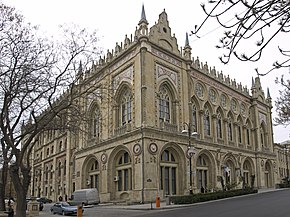
John Ruskin supplemented Pugin's ideas in his two influential theoretical works, The Seven Lamps of Architecture (1849) and The Stones of Venice (1853). Finding his architectural ideal in Venice, Ruskin proposed that Gothic buildings excelled above all other architecture because of the "sacrifice" of the stone-carvers in intricately decorating every stone. In this, he drew a contrast between the physical and spiritual satisfaction which a medieval craftsman derived from his work, and the lack of these satisfactions afforded to modern, industrialised labour.[l][107]
By declaring the Doge's Palace to be "the central building of the world", Ruskin argued the case for Gothic government buildings as Pugin had done for churches, though mostly only in theory. When his ideas were put into practice, Ruskin often disliked the result, although he supported many architects, such as Thomas Newenham Deane and Benjamin Woodward, and was reputed to have designed some of the corbel decorations for that pair's Oxford University Museum of Natural History.[108] A major clash between the Gothic and Classical styles in relation to governmental offices occurred less than a decade after the publication of The Stones of Venice. A public competition for the construction of a new Foreign Office in Whitehall saw the decision to award first place to a Gothic design by George Gilbert Scott overturned by the Prime Minister, Lord Palmerston, who successfully demanded a building in the Italianate style.[m][110]
Ecclesiology and funerary style
[edit]In England, the Church of England was undergoing a revival of Anglo-Catholic and ritualist ideology in the form of the Oxford Movement, and it became desirable to build large numbers of new churches to cater for the growing population, and cemeteries for their hygienic burials. This found ready exponents in the universities, where the ecclesiological movement was forming. Its proponents believed that Gothic was the only style appropriate for a parish church, and favoured a particular era of Gothic architecture – the "decorated". The Cambridge Camden Society, through its journal The Ecclesiologist, was so savagely critical of new church buildings that were below its exacting standards and its pronouncements were followed so avidly that it became the epicentre of the flood of Victorian restoration that affected most of the Anglican cathedrals and parish churches in England and Wales.[111]

St Luke's Church, Chelsea, was a new-built Commissioner's Church of 1820–1824, partly built using a grant of £8,333 towards its construction with money voted by Parliament as a result of the Church Building Act of 1818.[112] It is often said to be the first Gothic Revival church in London,[113] and, as Charles Locke Eastlake put it: "probably the only church of its time in which the main roof was groined throughout in stone".[114] Nonetheless, the parish was firmly low church, and the original arrangement, modified in the 1860s, was as a "preaching church" dominated by the pulpit, with a small altar and wooden galleries over the nave aisle.[115]
The development of the private major metropolitan cemeteries was occurring at the same time as the movement; Sir William Tite pioneered the first cemetery in the Gothic style at West Norwood in 1837, with chapels, gates, and decorative features in the Gothic manner, attracting the interest of contemporary architects such as George Edmund Street, Barry, and William Burges. The style was immediately hailed a success and universally replaced the previous preference for classical design.[116]
Not every architect or client was swept away by this tide. Although Gothic Revival succeeded in becoming an increasingly familiar style of architecture, the attempt to associate it with the notion of high church superiority, as advocated by Pugin and the ecclesiological movement, was anathema to those with ecumenical or nonconformist principles. Alexander "Greek" Thomson launched a famous attack; "We are told we should adopt [Gothic] because it is the Christian style, and this most impudent assertion has been accepted as sound doctrine even by earnest and intelligent Protestants; whereas it ought only to have force with those who believe that Christian truth attained its purest and most spiritual development at the period when this style of architecture constituted its corporeal form".[117] Those rejecting the link between Gothic and Catholicism looked to adopt it solely for its aesthetic romantic qualities, to combine it with other styles, or look to northern European Brick Gothic for a more plain appearance; or in some instances all three of these, as at the non-denominational Abney Park Cemetery in east London, designed by William Hosking FSA in 1840.[118]
Viollet-le-Duc and Iron Gothic
[edit]
France had lagged slightly in entering the neo-Gothic scene, but produced a major figure in the revival in Eugène Viollet-le-Duc. As well as a powerful and influential theorist, Viollet-le-Duc was a leading architect whose genius lay in restoration.[n] He believed in restoring buildings to a state of completion that they would not have known even when they were first built, theories he applied to his restorations of the walled city of Carcassonne,[64] and to Notre-Dame and Sainte Chapelle in Paris.[62] In this respect he differed from his English counterpart Ruskin, as he often replaced the work of mediaeval stonemasons. His rational approach to Gothic stood in stark contrast to the revival's romanticist origins.[120][121] Throughout his career he remained in a quandary as to whether iron and masonry should be combined in a building. Iron, in the form of iron anchors, had been used in the most ambitious buildings of medieval Gothic, especially but not only for tracery.
It had in fact been used in "Gothic" buildings since the earliest days of the revival. In some cases, cast iron enabled something like a perfection of medieval design. It was only with Ruskin and the archaeological Gothic's demand for historical truth that iron, whether it was visible or not, was deemed improper for a Gothic building. Ultimately, the utility of iron won out: "substituting a cast iron shaft for a granite, marble or stone column is not bad, but one must agree that it cannot be considered as an innovation, as the introduction of a new principle. Replacing a stone or wooden lintel by an iron breastsummer is very good".[122] He strongly opposed illusion, however: reacting against the casing of a cast iron pillar in stone, he wrote; "il faut que la pierre paraisse bien être de la pierre; le fer, du fer; le bois, du bois" (stone must appear to be stone; iron, iron; wood, wood).[123]
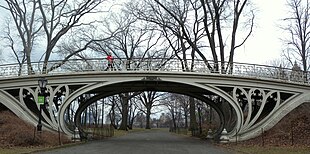
The arguments against modern construction materials began to collapse in the mid-19th century as great prefabricated structures such as the glass and iron Crystal Palace and the glazed courtyard of the Oxford University Museum of Natural History were erected, which appeared to embody Gothic principles.[o][125][126] Between 1863 and 1872 Viollet-le-Duc published his Entretiens sur l'architecture, a set of daring designs for buildings that combined iron and masonry.[127] Though these projects were never realised, they influenced several generations of designers and architects, notably Antoni Gaudí in Spain and, in England, Benjamin Bucknall, Viollet's foremost English follower and translator, whose masterpiece was Woodchester Mansion.[128] The flexibility and strength of cast-iron freed neo-Gothic designers to create new structural Gothic forms impossible in stone, as in Calvert Vaux's cast-iron Gothic bridge in Central Park, New York dating from the 1860. Vaux enlisted openwork forms derived from Gothic blind-arcading and window tracery to express the spring and support of the arching bridge, in flexing forms that presage Art Nouveau.[129]
Collegiate Gothic
[edit]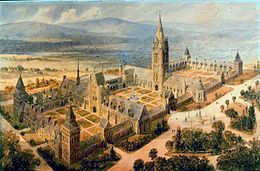
In the United States, Collegiate Gothic was a late and literal resurgence of the English Gothic Revival, adapted for American college and university campuses. The term "Collegiate Gothic" originated from American architect Alexander Jackson Davis's handwritten description of his own "English Collegiate Gothic Mansion" of 1853 for the Harrals of Bridgeport.[130][131] By the 1890s, the movement was known as "Collegiate Gothic".[132]
The firm of Cope & Stewardson was an early and important exponent, transforming the campuses of Bryn Mawr College,[133] Princeton University[134] and the University of Pennsylvania in the 1890s.[135] In 1872, Abner Jackson, the President of Trinity College, Connecticut, visited Britain, seeking models and an architect for a planned new campus for the college. William Burges was chosen and he drew up a four-quadrangled masterplan, in his Early French style. Lavish illustrations were produced by Axel Haig.[136] However, the estimated cost, at just under one million dollars, together with the sheer scale of the plans, thoroughly alarmed the College Trustees[137] and only one-sixth of the plan was executed, the present Long Walk, with Francis H. Kimball acting as local, supervising, architect, and Frederick Law Olmsted laying out the grounds.[136] Hitchcock considers the result, "perhaps the most satisfactory of all of [Burges's] works and the best example anywhere of Victorian Gothic collegiate architecture".[138]
The movement continued into the 20th century, with Cope & Stewardson's campus for Washington University in St. Louis (1900–1909),[139] Charles Donagh Maginnis's buildings at Boston College (1910s) (including Gasson Hall),[140] Ralph Adams Cram's design for the Princeton University Graduate College (1913),[141] and James Gamble Rogers' reconstruction of the campus of Yale University (1920s).[142] Charles Klauder's Gothic Revival skyscraper on the University of Pittsburgh's campus, the Cathedral of Learning (1926) exhibited Gothic stylings both inside and out, while using modern technologies to make the building taller.[143]
Vernacular adaptations and the revival in the Antipodes
[edit]
Carpenter Gothic houses and small churches became common in North America and other places in the late 19th century.[144] These structures adapted Gothic elements such as pointed arches, steep gables, and towers to traditional American light-frame construction. The invention of the scroll saw and mass-produced wood moldings allowed a few of these structures to mimic the florid fenestration of the High Gothic. But, in most cases, Carpenter Gothic buildings were relatively unadorned, retaining only the basic elements of pointed-arch windows and steep gables. A well-known example of Carpenter Gothic is a house in Eldon, Iowa, that Grant Wood used for the background of his painting American Gothic.[145]
New Zealand and Australia
[edit]Benjamin Mountfort, born in Britain, trained in Birmingham, and subsequently resident in Canterbury, New Zealand imported the Gothic Revival style to his adopted country and designed Gothic Revival churches in both wood and stone, notably in the city of Christchurch.[146] Frederick Thatcher designed wooden churches in the Gothic Revival style, for example Old St. Paul's, Wellington, contributing to what has been described as New Zealand's "one memorable contribution to world architecture".[147] St Mary of the Angels, Wellington by Frederick de Jersey Clere is in the French Gothic style, and was the first Gothic design church built in ferro-concrete.[148] The style also found favour in the southern New Zealand city of Dunedin, where the wealth brought in by the Otago gold rush of the 1860s allowed for substantial stone edifices to be constructed, using hard, dark breccia stone and a local white limestone, Oamaru stone, among them Maxwell Bury's University of Otago Registry Building[149] and the Dunedin Law Courts by John Campbell.[150]
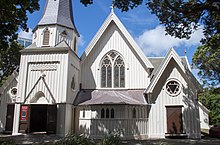
Australia, in particular in Melbourne and Sydney, saw the construction of large numbers of Gothic Revival buildings. William Wardell (1823–1899) was among the country's most prolific architects; born and trained in England, after emigrating his most notable Australian designs include St Patrick's Cathedral, Melbourne and St John's College and St Mary's Cathedral in Sydney. In common with many other 19th century architects, Wardell could deploy different styles at the command of his clients; Government House, Melbourne is Italianate.[151] His banking house for the English, Scottish and Australian Bank in Melbourne has been described as "the Australian masterpiece of neo-Gothic".[152] This claim has also been made for Edmund Blacket's MacLaurin Hall at the University of Sydney,[153] which sits in the quadrangle complex described as "arguably the most important group of Gothic and Tudor Revival style architecture in Australia".[154]
Global Gothic
[edit]
Henry-Russell Hitchcock, the architectural historian, noted the spread of the Gothic Revival in the 19th and early 20th centuries, "wherever English culture extended – as far as the West Coast of the United States and to the remotest Antipodes".[155] The British Empire, almost at its geographic peak at the height of the Gothic Revival, assisted or compelled this spread. The English-speaking dominions, Canada, Australia particularly the state of Victoria and New Zealand generally adopted British styles in toto (see above); other parts of the empire saw regional adaptations. India saw the construction of many such buildings, in styles termed Indo-Saracenic or Hindu-Gothic.[p][157] Notable examples include Chhatrapati Shivaji Terminus (formerly Victoria Terminus)[158] and the Taj Mahal Palace Hotel, both in Mumbai.[159] At the hill station of Shimla, the summer capital of British India, an attempt was made to recreate the Home counties in the foothills of the Himalayas. Although Gothic Revival was the predominant architectural style, alternatives were also deployed; Rashtrapati Niwas, the former Viceregal Lodge, has been variously described as Scottish Baronial Revival,[160] Tudor Revival[161] and Jacobethan.[q][163]
Other examples in the east include the late 19th century Church of the Saviour, Beijing, constructed on the orders of the Guangxu Emperor and designed by the Catholic missionary and architect Alphonse Favier;[164] and the Wat Niwet Thammaprawat in the Bang Pa-In Royal Palace in Bangkok, by the Italian Joachim Grassi.[165] In Indonesia, (the former colony of the Dutch East Indies), the Jakarta Cathedral was begun in 1891 and completed in 1901 by Dutch architect Antonius Dijkmans;[166] while further north in the islands of the Philippines, the San Sebastian Church, designed by architects Genaro Palacios and Gustave Eiffel, was consecrated in 1891 in the still Spanish colony.[167] Church building in South Africa was extensive, with little or no effort to adopt vernacular forms. Robert Gray, the first bishop of Cape Town, wrote; "I am sure we do not overestimate the importance of real Churches built after the fashion of our English churches". He oversaw the construction of some fifty such buildings between 1848 and his death in 1872.[r][169] South America saw a later flourishing of the Revival, particularly in church architecture,[170] for example the Metropolitan Cathedral of São Paulo in Brazil by the German Maximilian Emil Hehl,[171] and the Cathedral of La Plata in Argentina.[172]
20th and 21st centuries
[edit]
The Gothic style dictated the use of structural members in compression, leading to tall, buttressed buildings with interior columns of load-bearing masonry and tall, narrow windows. But, by the start of the 20th century, technological developments such as the steel frame, the incandescent light bulb and the elevator made this approach obsolete. Steel framing supplanted the non-ornamental functions of rib vaults and flying buttresses, providing wider open interiors with fewer columns interrupting the view.
Some architects persisted in using Neo-Gothic tracery as applied ornamentation to an iron skeleton underneath, for example in Cass Gilbert's 1913 Woolworth Building[173] skyscraper in New York and Raymond Hood's 1922 Tribune Tower in Chicago.[174] The Tower Life Building in San Antonio, completed in 1929, is noted for the arrays of decorative gargoyles on its upper floors.[175] But, over the first half of the century, Neo-Gothic was supplanted by Modernism, although some modernist architects saw the Gothic tradition of architectural form entirely in terms of the "honest expression" of the technology of the day, and saw themselves as heirs to that tradition, with their use of rectangular frames and exposed iron girders.

In spite of this, the Gothic Revival continued to exert its influence, simply because many of its more massive projects were still being built well into the second half of the 20th century, such as Giles Gilbert Scott's Liverpool Cathedral[176] and the Washington National Cathedral (1907–1990).[177] Ralph Adams Cram became a leading force in American Gothic, with his most ambitious project the Cathedral of St. John the Divine in New York (claimed to be the largest cathedral in the world), as well as Collegiate Gothic buildings at Princeton University.[178] Cram said "the style hewn out and perfected by our ancestors [has] become ours by uncontested inheritance".[179]
Though the number of new Gothic Revival buildings declined sharply after the 1930s, they continue to be built. St Edmundsbury Cathedral, the cathedral of Bury St Edmunds in Suffolk, was expanded and reconstructed in a neo-Gothic style between the late 1950s and 2005, and a commanding stone central tower was added.[180] A new church in the Gothic style is planned for St. John Vianney Parish in Fishers, Indiana.[181][182] The Whittle Building at Peterhouse, University of Cambridge, opened in 2016, matches the neo-Gothic style of the rest of the courtyard in which it is situated.[183]
Appreciation
[edit]К 1872 году готическое возрождение в Соединенном Королевстве стало достаточно зрелым, чтобы Чарльз Локк Истлейк , влиятельный профессор дизайна, смог написать «Историю готического возрождения» . [184] Kenneth Clark's, The Gothic Revival. An Essay, followed in 1928, in which he described the Revival as "the most widespread and influential artistic movement which England has ever produced."[185] The architect and writer Harry Stuart Goodhart-Rendel covered the subject of the Revival in an appreciative way in his Slade Lectures in 1934.[s][187] But the conventional early 20th century view of the architecture of the Gothic Revival was strongly dismissive, critics writing of "the nineteenth century architectural tragedy",[188] ridiculing "the uncompromising ugliness"[189] of the era's buildings and attacking the "sadistic hatred of beauty" of its architects.[190][t] The 1950s saw further signs of a recovery in the reputation of Revival architecture. John Steegman's study, Consort of Taste (re-issued in 1970 as Victorian Taste, with a foreword by Nikolaus Pevsner), was published in 1950 and began a slow turn in the tide of opinion "towards a more serious and sympathetic assessment."[192] In 1958, Henry-Russell Hitchcock published his Architecture: Nineteenth and Twentieth Centuries, as part of the Pelican History of Art series edited by Nikolaus Pevsner. Hitchcock devoted substantial chapters to the Gothic Revival, noting that, while "there is no more typical nineteenth-century product than a Victorian Gothic church",[193] the success of the Victorian Gothic saw its practitioners design mansions,[84] castles,[194] colleges,[195] and parliaments.[193] The same year saw the foundation of the Victorian Society in England and, in 1963, the publication of Victorian Architecture, an influential collection of essays edited by Peter Ferriday.[196] By 2008, the fiftieth anniversary of the founding of the Victorian Society, the architecture of the Gothic Revival was more fully appreciated with some of its leading architects receiving scholarly attention and some of its best buildings, such as George Gilbert Scott's St Pancras Station Hotel, being magnificently restored.[197] Публикация Общества, посвященная 50-летнему юбилею, «Спасение столетия » дала обзор потерь и успехов за полвека, отразила изменение восприятия викторианской архитектуры и завершилась главой, озаглавленной «Викторианцы-победители». [198]
Галерея
[ редактировать ]Европа
[ редактировать ]- Здание венгерского парламента , Будапешт , Венгрия: 1885–1904 гг.
- Ратуша Манчестера , Англия: 1868–1877 гг.
- Новая ратуша , Мюнхен , Германия: 1867–1874 гг.
- Железнодорожный вокзал Сент-Панкрас , Лондон, Англия: 1863–1868 гг.
- Станция Россиу , Лиссабон , Португалия: 1886–1887 гг.
- Шверинский замок , Германия: 1845–1857 гг.
- Дворец Стурдза , Ясский уезд , Румыния: 1880–1904 гг.
- Венская ратуша , Австрия: 1872–1883 гг.
- Замок Де Хаар , Утрехт , Нидерланды: 1892–1907 гг.
Северная Америка
[ редактировать ]- Собор Санта-Ана , Сальвадор: 1906–1913 гг.
- Рокфеллер-колледж , Принстон , США: 1877 г.
- Искупительный храм Святого Причастия , Гвадалахара, Халиско , Мексика: 1897–1972 гг.
- Собор Святого Патрика , Нью-Йорк, США: 1858–1879 гг.
Южная Америка
[ редактировать ]- Базилика Богоматери Луханской , провинция Буэнос-Айрес , Аргентина: 1890–1935 гг.
- Базилика Сальвадора , Сантьяго , Чили: 1913–1954 гг.
- Часовня Кристо Побре, Хауха , Перу: 1884–1925 гг.
- Собор Сан-Педро-де-Алькантара , Петрополис , Бразилия: 1884–1925 гг.
- Замок Фискального острова , Рио-де-Жанейро , Бразилия: 1881–1889 гг.
- Церковь Богоматери Лурдской , Канела , Бразилия: 1953–1987 гг.
Австралия и Новая Зеландия
[ редактировать ]- Сиднейский университет Четырехугольника , Сидней, Австралия: 1854–1862 гг.
- Собор Святого Патрика, Мельбурн , Австралия: 1858-1939 гг.
- Собор Крайстчерч , Новая Зеландия: 1864–1904 гг.
- Высокий суд Окленда , Новая Зеландия: 1865–1867 гг.
- Собор Святой Марии, Сидней , Австралия: 1868–1928 гг.
- Собор Святого Павла, Мельбурн , Австралия: 1880–1891 гг.
- Средняя школа для мальчиков Отаго , Новая Зеландия: 1882–1885 гг.
- Собор Святого Сердца, Бендиго , Австралия: 1895–1901 гг.
Азия
[ редактировать ]- Церковь Спаса , Баку , Азербайджан: 1896–1899 гг.
- Базилика Святого Сердца Иисуса , Пондичерри , Индия: 1902–1907 гг.
- Джакартский собор , Индонезия: 1891–1901 гг.
- Малая базилика Сан-Себастьяна , Манила , Филиппины: 1888–1891 гг.
- Собор Святого Сердца , Гуанчжоу , Китай: 1861–1888 гг.
- Государственный колледж университета, Лахор , Пакистан: 1 877 г.
Декоративное искусство
[ редактировать ]- Чашка и блюдце, производства Севрской фарфоровой фабрики и украшенные Пьером Юаром , 1827 год, фарфор, Кливлендский художественный музей , Кливленд , Огайо , США
- Часы неизвестного французского производителя, ок. 1835–1840 , позолота и патинированная бронза, Музей декоративного искусства , Париж.
- Пара ваз работы Александра-Эвариста Фрагонара и Севрской фарфоровой фабрики, изготовлены в 1832 году, украшены в 1844 году, твердый фарфор, Метрополитен-музей , Нью-Йорк.
- Письменный стол Кимбела и Кабуса , ок. 1877 г. , дуб, никелированная латунь и железная фурнитура, Метрополитен-музей.
См. также
[ редактировать ]Подразновидности стиля готического возрождения.
[ редактировать ]Местный
[ редактировать ]Сноски
[ редактировать ]- ↑ Инициатором косметического ремонта Университетского колледжа был сэр Роджер Ньюдигейт , который также провел «готику» своего загородного дома в Уорикшире, Арбери-Холл , в течение 50 лет во второй половине 18 века. [16]
- ↑ Это была оценка Уолполом фиктивного замка в Хэгли-парке, Вустершир, спроектированного его другом Сандерсоном Миллером . [24]
- ↑ Экскурсии по дому, проводимые экономкой Уолпола Маргарет Янг, оказались чрезвычайно популярными. Уолпол написал другу; «Меня так мучают толпы людей, приходящих посмотреть на мой дом, а Маргарет получает такие суммы денег, показывая его, что я собираюсь жениться на ней». [25]
- ^ Зал Альфреда, построенный лордом Батерстом в его поместье Сайренсестер-Парк между 1721 и 1732 годами в честь Альфреда Великого . [28] возможно, самое раннее сооружение в стиле готического возрождения в Англии. [29]
- ↑ Малоисследованный замок Клируэлл в Глостершире, построенный Роджером Моррисом , который также работал в Инверари , был описан как «самый ранний замок готического возрождения в Англии». [31]
- ↑ Томас Рикман получил образование бухгалтера, и его посмертная слава основывалась на его антикварных исследованиях, а не на его значительном корпусе зданий, которые пренебрегались как творения архитектора-самоучки. Лишь ближе к концу его жизни и после этого должность архитектора была признана профессией с учреждением Института британских архитекторов в 1834 году и Архитектурной ассоциации в 1847 году. [39]
- ^ Романы сэра Вальтера Скотта популяризировали период Средневековья, и их влияние вышло далеко за рамки архитектуры. Историк Роберт Бартлетт отмечает, что в какой-то момент в середине XIX века четыре разные сценические адаптации «Айвенго» , и на основе этого произведения были сняты девять отдельных опер. в лондонских театрах одновременно шли [46]
- ^ В Монреале, Квебек, Канада, более ранняя неоготическая базилика Нотр-Дам (1824 г.) принадлежит к готическому возрождению, экспортированному из Великобритании и США. Его архитектор Джеймс О'Доннелл был ирландским иммигрантом, не имеющим никаких известных связей с Францией. [68]
- ↑ Выбор канонизированной жены короля Хлодвига , первого христианского короля объединенной Франции, имел большое значение для Бурбонов . [69]
- ^ Впоследствии Пугин отрекся, написав во второй из двух своих лекций « Истинные принципы остроконечной или христианской архитектуры» ; «Человек, который остается какое-то время в современной готической комнате и убегает, не будучи раненым некоторыми из ее мелочей, может считать себя чрезвычайно удачливым. Часто вокруг рамы трюмо столько башен и фронтонов, сколько можно найти. в церкви я совершил многие из этих чудовищ в мебели, которую я спроектировал несколько лет назад для Виндзорского замка... В совокупности они выглядели полной пародией остроумного дизайна». [98]
- ↑ Пугин записал свой восторг по поводу разрушения того, что он считал совершенно неадекватными более ранними реставрациями Джеймса Вятта и Джона Соуна . «Вы, несомненно, видели отчеты о недавнем великом пожаре в Вестминстере. Не о чем особо сожалеть… огромное количество смесей Соуна и ересей Уайетта были преданы забвению. О, это было великолепное зрелище — видеть его составные миллионеры. и цементные вершины летят и трескаются». [103]
- ↑ Раскин также испытывал отвращение к современным «реставраторам» готических зданий. В предисловии к первому изданию своих «Семи ламп архитектуры » он заметил; «[Моё] всё время в последнее время было занято съемкой рисунков с одной стороны зданий, другую из которых каменщики сносили». [106]
- ↑ Слух о том, что Скотт перепрофилировал дизайн своего министерства иностранных дел для отеля Midland Grand Hotel , необоснован. [109]
- ^ В предисловии к своему Словарю французской архитектуры XI-XVI веков (1854–1868) ( Dictionnaire raisonné de l'architecture française du XIe au XVIe siècle ) ле-Дюк писал о незнании готической архитектуры, преобладающем в начале XIX век: «что касается [зданий], которые были построены между концом Римской империи и пятнадцатым веком, о них почти не говорили, за исключением того, что их называли продуктом невежества или варварства». [119]
- ↑ Раскин не был впечатлен Джозефа Пакстона , Хрустальным дворцом описав его как не что иное, как «теплицу, большую, чем когда-либо построенная теплица». [124]
- ^ Уильяма Берджеса Неосуществленные планы относительно Школы искусств сэра Дж. Дж. , «самый чудесный проект, который он когда-либо создавал», были описаны как «неотразимая жесткая готика тринадцатого века, отвечающая требованиям жаркой зоны ». [156]
- ^ Томас Р. Меткалф в своем исследовании «Имперское видение: индийская архитектура и британское владычество » записывает дебаты в Королевском обществе искусств в Лондоне в 1873 году между сторонниками европейского и местного подходов. В то время как Т. Роджер Смит утверждал, что «поскольку наша администрация демонстрирует европейскую справедливость, порядок, закон и честь, наши здания должны соответствовать высоким стандартам европейского искусства», Уильям Эмерсон утверждал, что «это невозможно для архитектуры запад, чтобы быть подходящим для туземцев востока». [162]
- ↑ Необычной особенностью программы строительства церквей, курируемой епископом Греем, было то, что большинство церквей были спроектированы его женой Софи , что было значительной редкостью в то время, когда женщины были почти полностью исключены из профессии . [168]
- ↑ В своей речи в 1976 году по случаю получения золотой медали RIBA сэр Джон Саммерсон напомнил о вкладе Ренделя; «Было хорошо известно, что викторианская архитектура была плохой или ужасно смешной, или и то, и другое. Рендел не соглашался, но что действительно ошеломило его аудиторию, так это то, что он знал, и знал в мельчайших деталях, о чем говорил». [186]
- ↑ Кеннет Кларк , несмотря на свой сочувственный подход, вспоминал, что в годы его пребывания в Оксфорде вообще считалось, что не только колледж Кебл был «самым уродливым зданием в мире», но и что его архитектором был Джон Раскин , автор «Камней Венеции ». Колледж был построен по проекту архитектора Уильяма Баттерфилда . [191]
Ссылки
[ редактировать ]- ^ Curl 1990 , стр. 14–15.
- ^ «Пугин и готическое возрождение» . Архивировано из оригинала 6 октября 2007 года . Проверено 12 июля 2010 г.
- ^ Перейти обратно: а б Кук 1987 , с. 383.
- ^ «Замок Отранто: Предметы коллекции» . Британская библиотека . Архивировано из оригинала 24 апреля 2023 года . Проверено 20 августа 2023 г.
- ^ Робсон Скотт 1965 , с. неизвестный.
- ^ Фюрно Джордан 1979 , с. 127.
- ^ Фюрно Джордан 1979 , с. 163.
- ^ Фюрно Джордан 1979 , с. 165.
- ^ Хантер, Боб (18 сентября 2014 г.). «Лондондеррский собор» . Войны и конфликты: Плантация Ольстера . Би-би-си.
- ^ Шервуд и Певснер 2002 , стр. 110–111.
- ^ «Северная Ирландия - Детали исторического здания HB17/15/022 A, Дроморский собор» . Департамент сообществ – правительство штата Нью-Йорк . Проверено 17 августа 2023 г.
- ^ Историческая Англия . «Ламбетский дворец (I класс) (1116399)» . Список национального наследия Англии . Проверено 17 августа 2023 г.
- ^ Историческая Англия . «Церковь Святого Николая, Альчестер (I класс) (1200612)» . Список национального наследия Англии . Проверено 17 августа 2023 г.
- ^ Маколей 1975 , с. 31.
- ^ «Везле и готика как конструктивный акт» (на французском языке). Universalis.fr . Проверено 17 августа 2023 г.
- ^ Историческая Англия . «Арбери Холл (класс!) (1185222)» . Список национального наследия Англии . Проверено 20 августа 2023 г.
- ^ Кокс 2012 , с. 117.
- ^ «Эглиз Сент-Эсташ» . Туристический офис Парижа . Проверено 6 мая 2020 г.
- ^ «Гуарино Гуарини: итальянский архитектор, священник, математик и теолог» . Британская энциклопедия. нд . Проверено 7 сентября 2018 г.
- ^ «Паломническая церковь Св. Яна Непомуцкого на Зеленой Горе» . Центр всемирного наследия ЮНЕСКО . Организация Объединенных Наций по вопросам образования, науки и культуры . Проверено 24 февраля 2023 г.
- ^ Надь, Гергей Домонкос (2013). «Готические здания и роль символов в архитектуре барокко» . Периодика Политехнической Архитектуры . 44 (2): 69–76. дои : 10.3311/PPar.7396 . ISSN 1789-3437 .
- ^ Олдрич 2005 , с. 140.
- ^ Чалкрафт и Вискарди 2007 , с. 7.
- ^ Перейти обратно: а б Брукс и Певснер 2007 , с. 339.
- ^ Чалкрафт и Вискарди 2007 , с. 20.
- ^ Историческая Англия . «Земляничный холм (Педагогический колледж Святой Марии) (I класс) (1261987)» . Список национального наследия Англии . Проверено 6 мая 2020 г.
- ^ Историческая Англия . «Аббатство Лакок с конюшенным двором (уровень I) (1283853)» . Список национального наследия Англии . Проверено 6 мая 2020 г.
- ^ Историческая Англия . «Альфредс-холл, Сайренсестер-парк (класс II *) (1298719)» . Список национального наследия Англии . Проверено 2 мая 2020 г.
- ^ Чарльзуорт 2002a , с. 14.
- ^ Олдрич 2005 , стр. 82–83.
- ^ Вери и Брукс 2002 , стр. 310–311.
- ^ Гиффорд 1989 , с. 161.
- ^ Крафт, Данбар и Фосетт 2006 , стр. 529.
- ^ Крафт, Данбар и Фосетт 2006 , стр. 744.
- ^ Маквильям 1978 , стр. 428–431.
- ^ Уайт и Уайт 1991 , с. 100.
- ^ «Бэтти Лэнгли, садовник и плодовитый писатель» . www.twickenham-museum.org.uk . Твикенхемский музей . Проверено 6 мая 2020 г.
- ^ Маколей 1975 , с. 174.
- ^ Олдрич 2019 , с. 25.
- ^ Рикман 1848 , с. 47.
- ^ Перейти обратно: а б Шеннон Кайлс. «Готическое возрождение (1750–1900)» . Архитектура Онтарио . Проверено 6 мая 2020 г.
- ^ «Готическое возрождение» . Британская онлайн- энциклопедия . Проверено 8 октября 2013 г.
- ^ Линдфилд 2016 , с. 78.
- ^ «Гид по стилю: Готическое возрождение» . Лондон, Великобритания: Музей Виктории и Альберта . Проверено 6 мая 2020 г.
- ^ «Томас Чиппендейл» . www.vam.ac.uk. Музей Виктории и Альберта. 26 ноября 2012 г.
- ^ Бартлетт 2001 , с. 14.
- ^ Линдфилд 2016 , с. 224.
- ^ Анструтер 1963 , предисловие.
- ^ Граур 1970 , стр. 233.
- ^ Шадене 2001 , стр. 116–117, 138.
- ^ Борода 1985 , с. 72.
- ^ Певснер 1951 , предисловие.
- ^ «Виктория: Готическая Корона» . Болдуинс. 19 марта 2019 г.
- ^ «Королева Виктория: Готическая корона 1847 года» . www.royalmint.com . Королевский монетный двор. Архивировано из оригинала 24 июня 2020 года . Проверено 6 мая 2020 г.
- ^ Бартлетт 2001 , с. 15.
- ^ «История Королевской капеллы в Дре» . Официальный сайт Chapelle Royale a Dreux . Проверено 29 мая 2020 г.
- ^ Готейн, Мария-Луиза. «История садового искусства – Англо-китайский сад» . www.gardenvisit.com . Пейзажный гид . Проверено 29 мая 2020 г.
- ^ «Коллекции Музея Нормандии» . mondes-normands.caen.fr . Нормандский музей . Проверено 6 мая 2020 г.
- ^ Ловенталь 2015 , с. 416.
- ^ Барнс, Джулиан (7 июля 2007 г.). «Вызывает инспектор» . Хранитель .
- ^ Мерфи, Кевин. «Память и современность: Виолле-ле-Дюк в Везле» . www.psupress.org . Издательство Пенсильванского государственного университета . Проверено 6 мая 2020 г.
- ^ Перейти обратно: а б Мидант 2002 , с. 54.
- ^ Мидант 2002 , с. 19.
- ^ Перейти обратно: а б с Мидант 2002 , с. 96.
- ^ «История замка -англ.-» .
- ^ «Мон-Сен-Мишель и его залив» . Центр всемирного наследия ЮНЕСКО . Проверено 6 мая 2020 г.
- ^ Мидант 2002 , с. 108.
- ^ Токер 1991 , с. XVIII–IX.
- ^ Менин 1775 , стр. 5.
- ^ «Западная архитектура – с 19 по начало 20 века» . Британская энциклопедия. нд . Проверено 6 мая 2020 г.
- ^ Брихта 2014 , с.
- ^ Германн 1972 , с. 152.
- ^ «Кёльнский собор: история, произведения искусства и факты» . Британская энциклопедия . Проверено 6 мая 2020 г.
- ^ «О соборе Святого Петра» . domplatz-5.de . Инфоцентрум Домплатц. Архивировано из оригинала 15 июля 2020 года . Проверено 6 мая 2020 г.
- ^ «Ульмский собор (Ульм, 1890 г.)» . Структуры . Проверено 6 мая 2020 г.
- ^ Форрест, ФГ «Собор Святого Вита» . www.fg.cz. Пражский Град . Проверено 6 мая 2020 г.
- ^ «Синт-Петрус-ан-Паулускерк» (на голландском языке). Город Остенде . Проверено 24 июля 2011 г.
- ^ «Стадхаус» (на голландском языке). Город Мехелен. Архивировано из оригинала 18 июля 2011 года . Проверено 18 июля 2011 г.
- ^ «Ратуша с бывшей Суконной галереей (ID: 3717)» . Опись архитектурного наследия (на голландском языке). Фламандский институт недвижимого наследия (VIOE) . Проверено 24 июля 2011 г.
- ^ «Флоренция» . Большой собор-музей . Проверено 6 мая 2020 г.
- ^ Тулешков 2007 , с. ?.
- ^ Марка 1995 г. , стр. 108–110.
- ^ Джексон 2011 , с. 152.
- ^ Перейти обратно: а б с Хичкок 1968 , с. 94.
- ^ Халл 2006 , с. 154.
- ^ Гленденнинг, Макиннес и Маккечни 2002 , стр. 276–285.
- ^ Перейти обратно: а б Буггельн 2003 , с. 115.
- ^ Джарвис 1814 .
- ^ Хобарт 1816 , с. 5.
- ^ Стэнтон 1997 , с. 3.
- ^ «Создание базилики – La Basilique Notre-Dame» . www.basiliquenotredame.ca . Нотр-Дам . Проверено 6 мая 2020 г.
- ^ «Здания парламента, Оттава, Онтарио, Канада» . Британская энциклопедия . Проверено 6 мая 2020 г.
- ^ «Мемориальный музей Виктории» . www.historicplaces.ca . Реестр исторических мест Канады . Проверено 6 мая 2020 г.
- ^ «Историческая мемориальная доска Королевского монетного двора Канады» . www.ontarioplaques.com . Исторические мемориальные доски Онтарио . Проверено 6 мая 2020 г.
- ^ «Национальный исторический памятник Канады, здание Коннахта» . www.pc.gc.ca. Парки Канады . Проверено 6 мая 2020 г.
- ^ Фултон 2005 .
- ^ Олдрич и Аттербери 1995 , с. 372.
- ^ Чарльзуорт 2002c , с. 199.
- ^ Хилл 2007 , стр. 74–75.
- ^ «Огастес Уэлби Нортмор Пьюджин (1812–1852)» . Викторианская паутина . Проверено 3 октября 2008 г.
- ^ Хилл 2007 , стр. 52–53.
- ^ Чарльзворт 2002c , стр. 168–171.
- ^ Аттербери и Уэйнрайт 1994 , с. 219.
- ^ Хилл 2007 , с. 317.
- ^ Аттербери и Уэйнрайт 1994 , с. 221.
- ^ Раскин 1989 , с. ix.
- ^ Чарльзуорт 2002c , с. 343.
- ^ Диксон и Мутезиус 1993 , с. 160.
- ^ Черри и Певснер 2002 , с. 362.
- ^ Марка 2015 г. , с. 152.
- ^ Кларк 1983 , стр. 155–174.
- ^ Порт 2006 , с. 327.
- ^ Германн 1972 , с. 9.
- ^ Истлейк 2012 , с. 141.
- ^ «Церковь Святого Луки – краткая история» . Приходской церковный совет святителя Луки . Проверено 2 ноября 2012 г.
- ^ «Кладбище Вест-Норвуд» . Институт искусств Курто. Архивировано из оригинала 16 июля 2020 года . Проверено 6 мая 2020 г.
- ^ Марка 1997 г. , с. 1.
- ^ Историческая Англия (1 октября 1987 г.). «Кладбище Эбни-Парк, Хакни (1000789)» . Список национального наследия Англии . Проверено 11 мая 2018 г.
- ^ Чарльзуорт 2002c , с. 611.
- ^ Певснер 1969 , с. 18.
- ^ Мидант 2002 , с. 35.
- ^ Мидант 2002 , с. 154.
- ^ Певснер 1969 , с. 17.
- ^ Певснер 1969 , с. 37.
- ^ «Хрустальный дворец Гайд-парка» . Университет Орегона. Архивировано из оригинала 12 марта 2012 года . Проверено 4 апреля 2008 г.
- ^ «Архитектура музея» . www.oumnh.ox.ac.uk . Музей естественной истории Оксфордского университета . Проверено 6 мая 2020 г.
- ^ Певснер 1969 , с. 34.
- ^ Историческая Англия . «Особняк, Вудчестер (1340703)» . Список национального наследия Англии . Проверено 11 мая 2018 г.
- ^ «Готический мост (94-я улица)» . www.centralpark.com . Центральный парк . Проверено 6 мая 2020 г.
- ^ Труеттнер, Джулия М. (31 декабря 2002 г.). Стремление к совершенству: Александр Джексон Дэвис и план первого кампуса Мичиганского университета, 1838 год . Издательство Мичиганского университета. п. 49. ИСБН 0472112775 . Проверено 16 марта 2018 г.
- ^ Головин, Энн Кастродейл. «Готический орнамент Бриджпорта, дом Харрал-Уилер» (PDF) . Смитсоновский институт . Издательство Смитсоновского института . Проверено 16 марта 2018 г.
- ^ Мартер, Джоан М.; Регейн, Мелисса (2011). Энциклопедия американского искусства Grove, Том 1 . Издательство Оксфордского университета. п. 362. ИСБН 9780195335798 . Проверено 16 марта 2018 г.
- ^ «Студенческая готика – Коуп и Стюардсон» . www.brynmawr.edu . Брин Маур. Архивировано из оригинала 3 марта 2019 года . Проверено 6 мая 2020 г.
- ^ «Готический роман Принстонского университета» . Журнал Принстон . Проверено 6 мая 2020 г.
- ^ «Архитектурные архивы: Школа дизайна Вейцмана» . www.design.upenn.edu . Пенсильванский университет . Проверено 6 мая 2020 г.
- ^ Перейти обратно: а б Крук 2013 , стр. 221–223.
- ^ Армстронг, Кристофер Дрю (июнь 2000 г.). «Qui Transtulit Sustinet» - Уильям Берджес, Фрэнсис Кимбалл и архитектура Тринити-колледжа Хартфорда». Журнал Общества историков архитектуры . 59 (2). University of California Press: 194–215. doi : 10.2307/991590 . JSTOR 991590 .
- ^ Хичкок 1968 , с. 187.
- ^ «История и традиции» . Вашингтонский университет в Сент-Луисе . Проверено 6 мая 2020 г.
- ^ «Магиннис, Чарльз Донах (1867–1955)» . Библиотеки Бостонского колледжа университета . Проверено 6 мая 2020 г.
- ^ «История аспирантуры» . gradschool.princeton.edu . Высшая школа Принстонского университета. Архивировано из оригинала 17 июля 2021 года . Проверено 6 мая 2020 г.
- ^ «Коллекция: Указатель архитектурных чертежей зданий Йельского университета Джеймса Гэмбла Роджерса | Архивы Йельского университета» . archives.yale.edu .
- ^ «Архитектурный архив Чарльза З. Клаудера» . Университет Карнеги-Меллон. Архивировано из оригинала 16 июля 2020 года . Проверено 6 мая 2020 г.
- ^ Поппелиерс, Чемберс и Шварц 1979 .
- ^ «Центр американского готического дома» . Wapellocounty.org . Совет по охране природы округа Вапелло. 18 декабря 2009 года. Архивировано из оригинала 18 июня 2009 года . Проверено 11 июня 2011 г.
- ^ Биографический словарь Новой Зеландии. «Маунтфорт, Бенджамин Вулфилд» . Teara.govt.nz . Министерство культуры и наследия Новой Зеландии . Проверено 6 мая 2020 г.
- ^ «Старый собор Святого Павла» . nzhistory.govt.nz . История Новой Зеландии онлайн . Проверено 6 мая 2020 г.
- ^ «Фредерик де Джерси Клер - Веллингтонское наследие» . wellingtoncityheritage.org.nz . Городской совет Веллингтона . Проверено 6 мая 2020 г.
- ^ Бери, Максвелл. «Здание Университета Отаго, Данидин» . Teara.govt.nz . Министерство культуры и наследия Новой Зеландии . Проверено 6 мая 2020 г.
- ^ «Правительственный архитектор – Джон Кэмпбелл – Веллингтонское наследие» . wellingtoncityheritage.org.nz . Городской совет Веллингтона . Проверено 6 мая 2020 г.
- ^ Рувольт, Джон. «Готика-возрождение» . Дом Федерации . Проверено 6 мая 2020 г.
- ^ Браун, Дженни. «Золотая эра неоготики» . Домен . Проверено 6 мая 2020 г.
- ^ Финнерти 2001 , с. 38.
- ^ «Сиднейский университет внесен в список государственного наследия» . АрхитектураAU.com . АРХИТЕКТУРА . Проверено 6 мая 2020 г.
- ^ Хичкок 1968 , с. 97.
- ^ Лондон 2002 , с. 22.
- ^ Моррис 1986 , с. 31.
- ^ Моррис 1986 , с. 133.
- ^ Моррис 1986 , стр. 149–150.
- ^ Моррис 1986 , с. 75.
- ^ «Ложа вице-короля (ныне Институт перспективных исследований), Шимла, Индия, автор Генри Ирвин» . www.victorianweb.org . Викторианская паутина . Проверено 6 мая 2020 г.
- ^ Меткалф 1989 , с. 1.
- ^ «Генри Ирвин и новый взгляд на индо-сарацинское движение: Ложа на холме Обсерватории» . www.victorianweb.org . Викторианская паутина . Проверено 6 мая 2020 г.
- ^ Кларк 2019 , с. XXIII.
- ^ Мексофаваннакул, Сарот (8 марта 2020 г.). «Готика, но буддизм» . Почта Бангкока . Проверено 5 мая 2020 г.
- ^ Сетиавати, Инда (6 мая 2013 г.). «Прихожане разделились по поводу установки в соборе кондиционера» . Джакарта Пост . Проверено 6 мая 2020 г.
- ^ «Церковь Сан-Себастьян» . ЮНЕСКО. Архивировано из оригинала 23 марта 2015 года . Проверено 11 мая 2018 г.
- ^ Мартин 2012 , с. 117.
- ^ Мартин 2012 , с. 121.
- ^ Сундт 2017 , стр. 119.
- ^ «Город Сан-Паулу» . Туристический офис города Сан-Паулу. Архивировано из оригинала 17 июля 2020 года . Проверено 6 мая 2020 г.
- ^ Сундт 2017 , стр. 124–125.
- ^ «Вулворт-билдинг» . Общество Касса Гилберта . Проверено 7 мая 2020 г.
- ^ «Трибунная башня» . Чикагский архитектурный центр . Проверено 7 мая 2020 г.
- ^ «Горгульи-охранники центра Сан-Антонио» . Новости США. 5 апреля 2020 г.
- ^ Историческая Англия . «Англиканский собор Христа, Ливерпуль (I класс) (1361681)» . Список национального наследия Англии . Проверено 5 мая 2020 г.
- ^ «Хронология» . Вашингтонский национальный собор . Проверено 6 мая 2020 г.
- ^ «Ральф Адамс Крам: американский архитектор и писатель» . Британская энциклопедия . Проверено 6 мая 2020 г.
- ^ Бартлетт 2001 , с. 21.
- ^ Пирман, Хью (13 марта 2005 г.). «Возвращение готов: последний англиканский собор почти закончен. И построен на 1000 лет» . Габион: сохранившиеся сочинения по архитектуре . Хью Пирман. Архивировано из оригинала 18 марта 2005 года.
- ^ Муни, Кэролайн (27 апреля 2008 г.). «Обнародованы архитектурные планы комплекса церкви и кампуса на следующие два десятилетия» . Католический момент . Лафайет, Индиана . Архивировано из оригинала 15 мая 2008 года.
- ^ «Сент-Джон Вианни Фишерс, Индиана» . HDB/Крэм и Фергюсон. Архивировано из оригинала 8 октября 2008 года . Проверено 3 октября 2008 г.
- ^ «Принц Уэльский открывает новое здание Уиттл» . Архитекторы Джона Симпсона . Проверено 6 мая 2020 г.
- ^ Eastlake 2012 , предисловие.
- ^ Кларк 1983 , с. 7.
- ^ Гудхарт-Рендел 1989 , с. 11.
- ^ Стигман 1970 , с. в.
- ^ Тернор 1950 , с. 111.
- ^ Тернор 1950 , с. 91.
- ^ Кларк 1983 , с. 191.
- ^ Кларк 1983 , с. 2.
- ^ Стигман 1970 , с. 2.
- ^ Перейти обратно: а б Хичкок 1968 , с. 100.
- ^ Хичкок 1968 , с. 95.
- ^ Хичкок 1968 , с. 96.
- ^ Ферридей 1963 , Введение.
- ^ Брэдли 2007 , с. 163.
- ^ Марка 2011 г. , стр. 43–44.
Источники
[ редактировать ]- Олдрич, Меган Брюстер; Аттербери, Пол (1995). АВН Пугин: Мастер готического возрождения . Нью-Хейвен и Лондон: Издательство Йельского университета. ISBN 978-0-300-06656-2 .
- Олдрич, Меган (2005). Готическое возрождение . Лондон: Phaidon Press. ISBN 978-0-714-83631-7 .
- Олдрич, Меган (2019). Меган Олдрич; Александрина Бьюкенен (ред.). Томас Рикман и викторианцы . Исследования викторианской архитектуры и дизайна. Том. 7. Лондон: Викторианское общество . ISBN 978-0-901-65756-5 . OCLC 1088560920 .
- Анструтер, Ян (1963). Рыцарь и зонтик: отчет об Эглинтонском турнире - 1839 г. Лондон: Джеффри Блес. ОСЛК 249701828 .
- Аттербери, Пол; Уэйнрайт, Клайв (1994). Пугин: Готическая страсть . Нью-Хейвен и Лондон: Издательство Йельского университета. ISBN 978-0-300-06656-2 . OCLC 750811794 .
- Бартлетт, Роберт (2001). Средневековая панорама . Лос-Анджелес: Публикации Гетти. ISBN 978-0-892-36642-2 .
- Борода, Джеффри (1985). Национальный фонд английской мебели . Лондон: Викинг. ISBN 978-0-670-80141-1 . OCLC 924269530 .
- Брэдли, Саймон (2007). Станция Сент-Панкрас . Лондон: Профильные книги. ISBN 978-1-861-97951-3 .
- Брихта, Томас (2014). Позднее завершение строительства Кельна и собора Святого Вита (M.Arch). Эдинбургский университет. hdl : 1842/9814 .
- Брукс, Алан; Певснер, Николаус (2007). Вустершир . Здания Англии. Издательство Йельского университета. ISBN 978-0-300-11298-6 .
- Буггельн, Гретхен Таунсенд (2003). Храмы благодати: материальное преобразование церквей Коннектикута . Ганновер, США: Публикации Университета Новой Англии. ISBN 978-1-584-65322-6 .
- Шадене, Сильви (2001). Французская мебель: от Людовика XIII до ар-деко . Бостон, США: Литтл, Браун и компания. ISBN 978-0-821-22683-4 .
- Чалкрафт, Анна; Вискарди, Джудит (2007). Строберри-Хилл: готический замок Горация Уолпола . Лондон: ISBN Фрэнсис Линкольн Лтд. 978-0-711-22687-6 . OCLC 255611525 .
- Чарльзуорт, Майкл (2002). Готическое возрождение 1720–1870 гг. – Литературные источники и документы: кровь и призраки . Том. 1. Робертсбридж, Восточный Суссекс: Информация о Хелме. ISBN 978-1-873-40367-9 . OCLC 491489502 .
- Чарльзуорт, Майкл (2002). Готическое возрождение 1720–1870 гг. – Литературные источники и документы: готика и национальная архитектура . Том. 3. Робертсбридж, Восточный Суссекс: Информация о Хелме. ISBN 978-1-873-40367-9 . OCLC 491489502 .
- Черри, Бриджит; Певснер, Николаус (2002). Лондон 4: Север . Здания Англии. Нью-Хейвен, США и Лондон: Издательство Йельского университета . ISBN 9780300096538 .
- Кларк, Энтони Э. (2019). Китайская готика: епископ Пекина и его собор . Вашингтон, США: Вашингтонский университет Press. ISBN 978-0-295-74668-5 .
- Кларк, Кеннет (1983). Готическое возрождение: очерк истории вкуса . Лондон: Джон Мюррей. ISBN 978-0-719-53102-6 .
- Кук, Роберт (1987). Вестминстерский дворец . Лондон: Бертон Скира. ISBN 978-2-882-49014-8 .
- Кокс, Оливер (8 ноября 2012 г.). «Оксфордский колледж и готическое возрождение восемнадцатого века» (PDF) . Оксониенсия : 117–136 . Проверено 20 августа 2023 г.
- Крук, Дж. Мордаунт (2013). Уильям Берджес и высокая викторианская мечта . Лондон: Фрэнсис Линкольн. ISBN 978-0-7112-3349-2 .
- Крафт, Китти; Данбар, Джон; Фосетт, Ричард (2006). Границы . Здания Шотландии. Нью-Хейвен, США и Лондон: Издательство Йельского университета . ISBN 978-0-300-10702-9 . OCLC 1062076262 .
- Керл, Джеймс Стивенс (1990). Викторианская архитектура . Ньютон Эббот, Девон и Лондон: Дэвид и Чарльз. ISBN 978-0-715-39144-0 .
- Диксон, Роджер; Мутезиус, Стефан (1993). Викторианская архитектура . Лондон: Темза и Гудзон. ISBN 978-0-195-20048-5 .
- Истлейк, Чарльз Локк (2012). История готического возрождения . Кембридж: Издательство Кембриджского университета. ISBN 978-1-108-05191-0 .
- Ферридей, Питер (1963). Викторианская архитектура . Лондон: Джонатан Кейп. ОСЛК 270335 .
- Финнерти, Энн (2001). Архитектура Восточной Австралии: архитектурная история в 432 отдельных презентациях . Фельбах, Германия: Издание Акселя Менгеса. ISBN 978-3-930-69890-5 .
- Фултон, Гордон В. (2005). «Юарт, Дэвид» . Словарь канадской биографии (онлайн-изд.). Университет Торонто Пресс .
- Фюрно Джордан, Роберт (1979). Краткая история западной архитектуры . Лондон: Темза и Гудзон. OCLC 757298161 .
- Германн, Георг (1972). Готическое возрождение в Европе и Великобритании: источники, влияния и идеи . Лондон: Лунд Хамфрис. ISBN 978-0-853-31343-4 .
- Гиффорд, Джон (1989). Уильям Адам 1689–1748: Жизнь и времена универсального архитектора Шотландии . Эдинбург: Основное издательство. ISBN 978-1-851-58296-9 . OCLC 600401309 .
- Гленденнинг, Майлз; Макиннес, Ранальд; МакКечни, Аонгхус (2002). История шотландской архитектуры: от эпохи Возрождения до наших дней . Эдинбург: Издательство Эдинбургского университета. ISBN 978-0-748-60741-9 .
- Гудхарт-Рендел, Гарри Стюарт (1989) [1953]. Английская архитектура времен Регентства: интерпретация . Лондон: Век. ISBN 978-0-712-61869-4 . OCLC 243386485 .
- Старлинг, Неага (1970). Стили в декоративном искусстве (на румынском языке). Бухарест: Церцес. OCLC 560131438 .
- Хилл, Розмари (2007). Божий архитектор: Пугин и строительство романтической Британии . Лондон: Аллен Лейн. ISBN 978-0-713-99499-5 .
- Хичкок, Генри-Рассел (1968) [1958]. Архитектура: девятнадцатый и двадцатый века . Пеликан История искусства . Лондон: Книги Пингвинов . OCLC 851173836 .
- Хобарт, Джон Генри (1816). Моральная эффективность и положительная польза таинств Евангелия: проповедь, произнесенная при освящении Троицкой церкви в городе Нью-Хейвен в среду, 21 февраля 1816 года нашей эры . Оливер Стил.
- Халл, Лиз (2006). Средневековые замки Британии . Лондон: Прегер. ISBN 978-0-275-98414-4 .
- Джексон, Элвин (2011). Два союза: Ирландия, Шотландия и выживание Соединенного Королевства, 1707–2007 гг . Оксфорд: Издательство Оксфордского университета. ISBN 978-0-199-59399-6 .
- Джарвис, Сэмюэл Фармар (1814). Речь, произнесенная в городе Нью-Хейвен: при закладке краеугольного камня Троицкой церкви 17 мая 1814 года . Оливер Стил.
- Линдфилд, Питер (2016). Грузинская готика: средневековая архитектура, мебель и интерьеры, 1730–1840 гг . Лондон: Бойделл и Брюэр. ISBN 978-1-783-27127-6 .
- Лондон, Кристофер В. (2002). Бомбейская готика . Мумбаи, Индия: Индийский книжный дом. ISBN 81-7508-329-8 .
- Ловенталь, Дэвид (2015). Прошлое — чужая страна . Возвращение к нему. Кембридж, Великобритания: Издательство Кембриджского университета . ISBN 978-0-521-85142-8 .
- Маколей, Джеймс (1975). Готическое возрождение 1745–1845 гг . Глазго и Лондон: Блэки. ISBN 978-0-216-89892-9 .
- Мартин, Десмонд (2012). «Епископ Роберт Грей и миссис София Грей: Строительство англиканских церквей в Южной Африке, 1848–1872 гг.». В Г. А. Бремнере (ред.). Экклезиология за рубежом: Британская империя и за ее пределами . Исследования викторианской архитектуры и дизайна. Том. 4. Лондон: Викторианское общество . ISBN 978-0-901-65753-4 . OCLC 825141174 .
- Менин, Николя (1775). Описание коронации королей и королев Франции . Лондон: неизвестно. OCLC 1064350166 .
- Меткалф, Томас Р. (1989). Имперское видение: индийская архитектура и британское владычество . Лондон: Фабер и Фабер. ISBN 978-0-571-15419-7 . OCLC 835581414 .
- Мидан, Жан-Поль (2002). Виолле-ле-Дюк: Французское готическое возрождение . Париж: Л'Авантюрин. ISBN 978-2-914-19922-3 .
- Моррис, Ян (1986). Камни Империи: Здания Раджа . Оксфорд, Великобритания: Издательство Оксфордского университета . ISBN 978-0-192-82036-5 . OCLC 473765817 .
- Маквильям, Колин (1978). Лотиан . Здания Шотландии. Хармондсворт, Миддлсекс: Penguin Books. ISBN 978-0-140-71066-3 . OCLC 185487752 .
- Певснер, Николаус (1951). Высокий викторианский дизайн: исследование экспонатов 1851 года . Лондон: Архитектурная пресса. OCLC 875412662 .
- Певснер, Николаус (1969). Рёскин и Виолле-Ле-Дюк: англичанство и французство в оценке готической архитектуры . Лондон: Темза и Гудзон. OCLC 264998275 .
- Поппелиерс, Джон; Чемберс, С. Аллен; Шварц, Нэнси (1979). Какой это стиль . Вашингтон: Пресса по сохранению. ISBN 978-0-891-33065-3 .
- Порт, Миннесота (2006). 600 новых церквей: Комиссия по церковному строительству 1818–1856 гг . Ридинг, Великобритания: Spire Books. ISBN 978-1-904-96508-4 .
- Рикман, Томас (1848). Попытка различить стили архитектуры в Англии: от завоевания к реформации . Лондон: Дж. Х. Паркер. п. 47 . дои : 10.1017/CBO9781107338241 . ISBN 978-1-107-33824-1 .
- Робсон Скотт, Уильям Дуглас (1965). Литературные предпосылки готического возрождения в Германии – глава в истории вкуса . Оксфорд: Кларендон Пресс. OCLC 504490694 .
- Раскин, Джон (1989) [1849]. Семь светильников архитектуры . Нью-Йорк: Dover Publications . ISBN 978-0-486-26145-4 . OCLC 19886931 .
- Шервуд, Дженнифер; Певснер, Николаус (1996). Оксфордшир . Здания Англии. Нью-Хейвен, США и Лондон: Издательство Йельского университета . ISBN 978-0-30009-6392 .
- Штамп, Гэвин (1995). К. Брукс (ред.). Викторианская церковь: пресвитерианская архитектура в Шотландии девятнадцатого века . Викторианская церковь: архитектура и общество. Манчестер: Издательство Манчестерского университета. ISBN 0-7190-4020-5 .
- — (1997). Каледония Готика: Пугин и готическое возрождение в Шотландии . Архитектурное наследие. Эдинбург: Журнал Общества архитектурного наследия Шотландии. OCLC 632385481 .
- — (2011). Спасение века: Викторианское общество, 1958–2008 гг . Лондон: Викторианское общество. ISBN 978-0-901-65740-4 . OCLC 1141858753 .
- — (2015). Готика для эпохи Steam: иллюстрированная биография Джорджа Гилберта Скотта . Лондон: Аурум Пресс. ISBN 978-1-781-31124-0 . OCLC 1123924291 .
- Стэнтон, Фиби Б. (1997). Готическое возрождение и американская церковная архитектура: эпизод вкуса, 1840–1856 гг . Балтимор, США и Лондон: Издательство Университета Джонса Хопкинса. ISBN 978-0-801-85622-8 . OCLC 38338245 .
- Стигман, Джон (1970). Викторианский вкус – исследование искусства и архитектуры с 1830 по 1870 годы . Кембридж: Университетские книги Нельсона в мягкой обложке. ISBN 978-0-262-69028-7 .
- Сундт, Ричард А. (2017). Тимоти Бриттен-Кэтлин; Ян Де Майер; Мартин Брессани (ред.). Готическое возрождение во всем мире: глобальное влияние AWN Pugin . Левен, Бельгия: Издательство Левенского университета. ISBN 978-9-462-70091-8 .
- Токер, Франклин (1991). Церковь Нотр-Дам в Монреале: архитектурная история . Монреаль: Издательство Макгилла – Королевского университета . ISBN 978-0-773-50848-4 .
- Тернор, Реджинальд (1950). Архитектура девятнадцатого века в Великобритании . Лондон: Бэтсфорд. OCLC 520344 .
- Тулешков, Николай (2007). Мастера-строители из Славине (на болгарском языке). София: Арка и искусство. ISBN 978-9-548-93140-3 . OCLC 264741060 .
- Вери, Дэвид; Брукс, Алан (2002) [1970]. Глостершир 2: Долина и лес Дина . Здания Англии. Нью-Хейвен, США и Лондон: Издательство Йельского университета. ISBN 9780300097337 .
- Уайт, Ян; Уайт, Кэтлин А. (1991). Меняющийся шотландский пейзаж, 1500–1800 гг . Лондон: Рутледж. ISBN 9780415029926 .
Дальнейшее чтение
[ редактировать ]- Кристиан Амальви, «Вкус средневековья» (Париж: Плон), 1996. Первая французская монография о французском готическом возрождении.
- «Ретро-готика» до Виолле-ле-Дюк . Выставка, 1979. Первая французская выставка, посвященная французской неоготике.
- Хантер-Штибель, Пенелопа, «О рыцарях и шпилях: готическое возрождение во Франции и Германии» , 1989. ISBN 0-614-14120-6 .
- Фиби Б. Стэнтон, Пугин (Нью-Йорк: Viking Press, 1972, © 1971). ISBN 0-670-58216-6 .
- Саммерсон, сэр Джон , 1948. «Виолле-ле-Дюк и рациональная точка зрения», собранные в «Небесных особняках» и других эссе по архитектуре .
- Сэр Томас Дж. Джексон , «Современная готическая архитектура» (1873 г.), «Византийская и романская архитектура» (1913 г.) и трехтомная «Готическая архитектура во Франции, Англии и Италии » (1901 г.).




